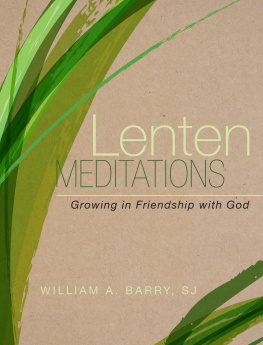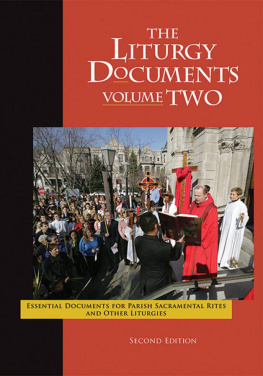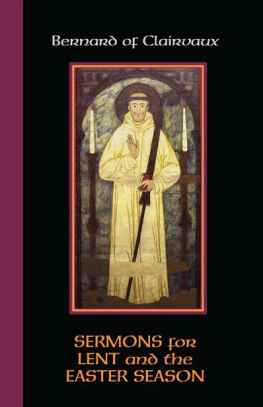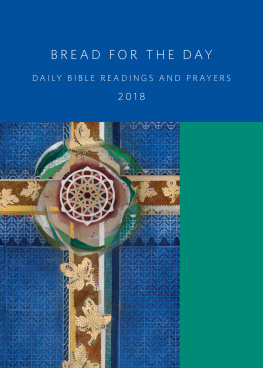Lent, Holy Week, Easter,
and the Great Fifty Days
Lent, Holy Week,
Easter, and the
Great Fifty Days
A Ceremonial Guide
Leonel L. Mitchell

A COWLEY PUBLICATIONS BOOK
ROWMAN & LITTLEFIELD PUBLISHERS, INC.
Published in the United States of America
by Rowman & Littlefield Publishers, Inc.
A wholly owned subsidiary of The Rowman & Littlefield Publishing Group, Inc.
4501 Forbes Boulevard, Suite 200, Lanham, Maryland 20706
www.rowmanlittlefield.com
Estover Road
Plymouth PL6 7PY
United Kingdom
Copyright 1996 by Leonel L. Mitchell
First Rowman & Littlefield edition 2007
Scripture quotations are from the New Revised Standard Version of the Bible, 1989 by the Division of Christian Education of the National Council of the Churches of Christ in the USA. Used by permission. All rights reserved.
All rights reserved. No part of this publication may be reproduced, stored in a retrieval system, or transmitted in any form or by any means, electronic, mechanical, photocopying, recording, or otherwise, without the prior permission of the publisher.
British Library Cataloguing in Publication Information Available
Library of Congress Cataloging-in-Publication Data
Mitchell, Leonel L. (Leonel Lake), 1930
Lent, Holy Week, Easter, and the great fifty days : a ceremonial guide / Leonel L. Mitchell.
p. cm.
This volume is a companion to The ceremonies of the Eucharist: a guide to celebration by the late Howard E. GalleyPref.
Includes bibliographical references.
ISBN-13: 978-1-56101-134-6 (pbk. : alk. paper)
ISBN-10: 1-56101-134-7 (pbk. : alk. paper)
1. Lent. 2. Easter. 3. Holy Week services. 4. Easter service. 5. Episcopal ChurchLiturgy. I. Galley, Howard. Ceremonies of the Eucharist. II. Title.
BV85.M57 1996
264'.03dc20
96-24910
CIP
Printed in the United States of America.
 The paper used in this publication meets the minimum requirements of American National Standard for Information SciencesPermanence of Paper for Printed Library Materials, ANSI/NISO Z39.48-1992.
The paper used in this publication meets the minimum requirements of American National Standard for Information SciencesPermanence of Paper for Printed Library Materials, ANSI/NISO Z39.48-1992.
In memory of Howard E. Galley
Cross references in this book refer to chapter sections and subsections, as listed in the Table of Contents. Thus 1.2 refers to the section The Service in Detail in the chapter on Ash Wednesday, and 1.2a refers to the subsection The Procession within that section.
The following abbreviations are used for these liturgical books referenced throughout this book. Page numbers refer to these editions unless otherwise noted.
BCP | The Book of Common Prayer (1979) |
BOS | The Book of Occasional Services (1994) |
LFF | Lesser Feasts and Fasts (1994) |
LHWE | Lent, Holy Week, Easter (1986) |
BAS | The Book of Alternative Services (1985) |
Contents
Preface
This volume is a companion to The Ceremonies of the Eucharist: A Guide to Celebration by the late Howard E. Galley. The general descriptions of the church and its furnishings, the liturgical ministries, music and liturgical practices, and the detailed directions for celebrating the eucharist and baptism given in The Ceremonies of the Eucharist are assumed in this volume and will not be repeated. Specifically, this guide to the liturgies of Lent, Holy Week, Easter, and the Great Fifty Days is intended for all who bear responsibility for the planning and conduct of public worship in medium-sized Episcopal churches. There are, in addition, directions for celebrating the major Holy Week liturgies in small congregations with fewer liturgical resources. Some congregations will find themselves in between the two descriptions, and will wish to follow the more elaborate model for some things and the simpler version for others. Other congregations will have even more resources availabletwo or more deacons, a number of priests, a large choir.
It needs to be said of books of ceremonial in general, and of this one in particular, that they often seem much more directive than they intend to be. Descriptions of services appear as a series of imperatives which, in the minds of some, attain a certain prescriptive value. But this is not really the case. The rubrics are directions for the celebration of the rites of The Book of Common Prayer or other service book. They are not intended to be straightjackets in which to bind the liturgical assembly. Obviously, some rubrics contain theologically significant statements about how the rite must be conducted to conform to the tradition of the Episcopal Church, or even of the Christian religion. Others set out a coherent way in which to accomplish this, and may require adapting to local conditions: directions which imply a church of a certain shape and arrangement and must be adapted to buildings of other shapes are an obvious example. Ceremonial guides are intended to interpret all of this in the light of a set of traditional (or nontraditional) liturgical principles.
The directions in this book provide a reasonable, consistent way in which to celebrate these liturgies. It is by no means the only possible way. The liturgy grows out of the life of actual individual congregations, and no two congregations will celebrate the liturgy in exactly the same way. Congregations are often extremely creative in their adaptation of the official liturgies to their particular circumstances. This is to be encouraged as long as it is consonant with the spirit of the celebration, but it is often impossible to export this creativity from one congregation to another.
The Episcopal Church is not a monocultural, English-speaking church. Its worship is conducted in many languages by people of many cultures, and these differences can and should affect the way in which liturgies are celebrated. These rites are celebrated in Spanish, French, Korean, and several Native American languages, among others, and the linguistic groups and the cultures which use them will all approach the liturgy in different ways, using different cultural idioms. Hispanic Holy Week customs and the all-night vigil traditions of the Lakotas readily find their place in the liturgical celebrations, but it would be a mistake for someone of a different culture, such as this writer, to attempt to tell them how to adapt the liturgies to their needs.
It is my intention in describing these liturgies to include everything that may reasonably be done, assuming that it is easier for a congregation to omit things that are described than to wonder how to do things that have been omitted.
I wish to acknowledge gratefully the assistance of the Rev. Jeffrey Lee and Deacon Ormonde Plater, who read the manuscript and made many helpful suggestions.
It was Howard Galleys intention to complete his earlier work with a second volume dealing with Lent, Holy Week, and Easter, and another with the pastoral offices. This volume on the paschal cycle is an earnest on his intention, and is dedicated to his memory. The ideas and implementation, however, are mine, and should not be blamed on Howard.
. Cambridge, Mass.: Cowley Publications, 1989.
Introduction
The Paschal
Cycle
The paschal mystery of the dying and rising again of Jesus Christ and our participation therein is the theological core of the gospel, and its liturgical celebration is the central event of the church year. This celebration includes not only the special services of Holy Week and the Easter Vigil, but a substantial part of the year, roughly from February to June, the seasons of Lent, Holy Week, and Easter.
Next page








 The paper used in this publication meets the minimum requirements of American National Standard for Information SciencesPermanence of Paper for Printed Library Materials, ANSI/NISO Z39.48-1992.
The paper used in this publication meets the minimum requirements of American National Standard for Information SciencesPermanence of Paper for Printed Library Materials, ANSI/NISO Z39.48-1992.